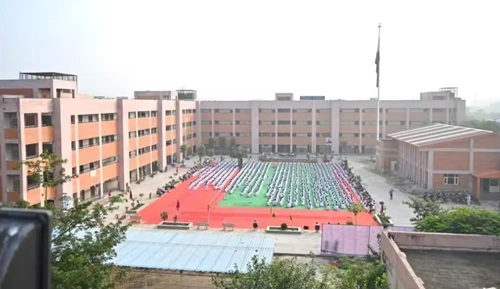Government schools in India are schools that are run and funded by the government. These schools provide education to children without charging high fees, making them affordable for families across the country. Government schools are spread across cities, towns, and villages, ensuring that education reaches as many children as possible. The government also provides free textbooks, uniforms, and mid-day meals to help students and encourage them to come to school.
Even though government schools play an important role in educating millions of children in India, they have their own advantages and disadvantages. Let us explore these points in detail to understand them better.

Advantages of Government Schools
1. Free or Low-Cost Education
One of the biggest advantages of government schools is that they provide free or very low-cost education. This helps children from poor families to attend school and get an education. For many families, sending their children to private schools is expensive, but government schools allow every child to learn without worrying about high fees.
2. Mid-Day Meal Scheme
Government schools in India provide free meals to students under the mid-day meal scheme. This ensures that children from low-income families get at least one nutritious meal during the day. The mid-day meal encourages regular attendance in schools and helps students focus better on their studies since they do not have to worry about hunger.
3. Availability Across the Country
Government schools are present in almost every part of India, including rural and remote areas. They make education accessible to children even in places where there are no private schools. This helps in improving literacy rates and providing education to children who otherwise might not have had the chance to go to school.
4. Diverse Student Community
Government schools often have students from different social, economic, and cultural backgrounds. This diversity helps children learn about other cultures and develop a sense of unity. They learn to work and grow together, which promotes social harmony and equality among students.
5. Qualified Teachers
In government schools, teachers are usually well-qualified and are appointed based on competitive exams. The government ensures that teachers have the necessary qualifications to teach students. This helps in maintaining the quality of education, especially in subjects like maths, science, and languages.
6. Focus on Inclusive Education
Government schools are more likely to focus on inclusive education, where children with special needs are given attention and support. There are provisions for children with physical or learning disabilities, ensuring that every child gets the opportunity to learn and grow.
7. Government-Sponsored Programs
Government schools benefit from various government-sponsored programs like free textbooks, scholarships, and skill development initiatives. These programs help students in their academic journey and ensure that they are provided with the resources they need to succeed in their studies.
Disadvantages of Government Schools
1. Lack of Proper Infrastructure
One of the major disadvantages of government schools is the lack of proper infrastructure. Many government schools do not have enough classrooms, clean toilets, playgrounds, or drinking water facilities. This can make the learning environment uncomfortable for students and affect their overall growth.
2. Shortage of Teachers
Government schools often face a shortage of teachers, especially in rural areas. This means that one teacher may have to teach multiple subjects or manage several classes at the same time. This can lead to a decline in the quality of education, as teachers are overburdened and cannot give individual attention to students.
3. Inadequate Learning Materials
Although the government provides free textbooks, other learning materials such as notebooks, pencils, and sports equipment are often not available in sufficient quantity. This lack of resources can affect the students’ learning experience, making it harder for them to perform well in school.
4. Limited Extracurricular Activities
Many government schools do not have enough facilities for extracurricular activities like sports, music, art, or drama. These activities are important for the overall development of children, as they help in building confidence, creativity, and teamwork. The absence of these activities means that students miss out on a holistic education.
5. Poor Maintenance and Cleanliness
The maintenance of government schools is often poor. Many schools are not regularly cleaned, and basic facilities like toilets may not be in good condition. Poor hygiene and cleanliness can affect the health of students and discourage them from attending school regularly.
6. Large Class Sizes
In many government schools, the class sizes are very large, with one teacher handling 40 to 50 students or more. In such cases, it becomes difficult for teachers to give individual attention to each student. This can lead to slower learning, especially for students who need extra help.
7. Lack of Modern Technology
While private schools often have access to modern technology like computers, smart boards, and digital learning tools, many government schools lack these resources. Without access to technology, students may not be able to keep up with modern learning methods and miss out on important skills like computer literacy.
Comparison Table: Government Schools vs. Private Schools
| Feature | Government Schools | Private Schools |
|---|---|---|
| Cost of Education | Free or very low cost | High fees |
| Infrastructure | Often lacks proper infrastructure | Well-maintained and modern facilities |
| Teacher Qualifications | Qualified teachers appointed by the government | Qualified but may vary between schools |
| Class Size | Large class sizes | Smaller class sizes |
| Extracurricular Activities | Limited or absent | Plenty of options |
| Access to Technology | Limited | More access to computers and smart tools |
| Diversity | High, students from various backgrounds | Less diverse, depending on the fee structure |
| Location | Available in rural and remote areas | Mostly in urban and developed areas |
Final Thoughts
Government schools in India play an important role in providing education to children across the country, especially those from low-income families. They offer free or low-cost education, making it accessible to everyone. Government schools also focus on equality and inclusivity, ensuring that every child, regardless of their background, gets a chance to learn.
However, government schools also face several challenges, such as poor infrastructure, a lack of teachers, and inadequate resources. These issues affect the quality of education and make it difficult for students to compete with those from private schools. To improve government schools, it is important for the government to invest more in infrastructure, teacher training, and modern learning tools.
In conclusion, while government schools have their disadvantages, they are a lifeline for millions of children in India. With more attention and resources, these schools can provide even better education and help shape the future of the country.
Hina Abbasi is Editor and a passionate sports and entertainment content writer at WinnersMaze.com. Hina’s expertise spans across a wide range of sports, and interest in many TV shows allowing her to deliver insightful analysis and compelling stories that resonate with readers.

